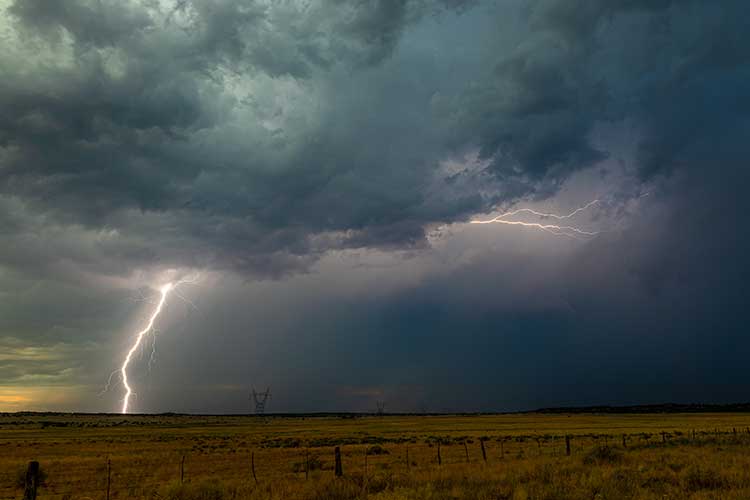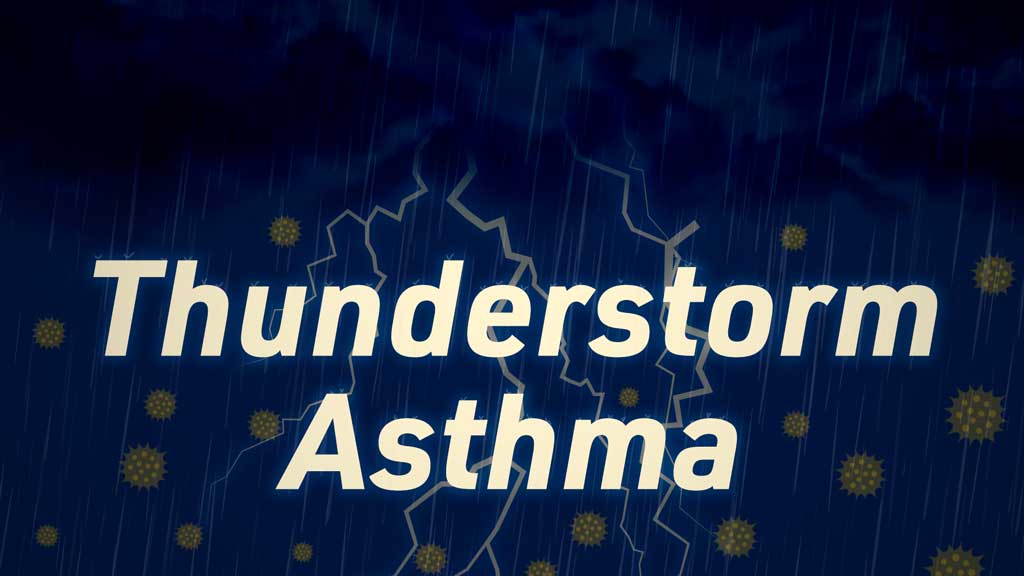At about 5:30 pm on the 21st of November 2016, during the peak of grass pollen season in Australia, Victoria was struck by a severe thunderstorm (Lanese 2021).
That evening and the following day, healthcare and emergency services around Melbourne and as far as Geelong were inundated with triple zero calls, emergency department presentations and ambulance requests from people experiencing critical respiratory issues (Lanese 2021; Hughes et al. 2022).
This unprecedented event - the most severe thunderstorm asthma epidemic ever recorded worldwide - resulted in 3,365 extra hospital presentations and 10 deaths (VIC DoH 2024; Hughes et al. 2022).
What is Thunderstorm Asthma?
Thunderstorm asthma occurs when high grass pollen levels and a specific type of thunderstorm align, triggering asthma symptoms in certain people. When a large number of people experience these symptoms over a short period of time, such as in the November 2016 incident, this is known as epidemic thunderstorm asthma (Better Health Channel 2024).
Thunderstorm asthma events are uncommon and difficult to predict as they require very specific weather conditions. However, the highest risk period is during grass pollen season (October to December) (SafeWork NSW 2023).
There have been 26 known epidemic thunderstorm asthma events worldwide, 11 of which occurred in Australia (mainly in the Melbourne area) (Venkatesan 2022).
The prevalence and severity of thunderstorm asthma in Victoria are believed to be associated with specific weather patterns, local plants and Australia having the highest rate of asthma worldwide (Connellan 2021).
What Causes Thunderstorm Asthma?
Thunderstorm asthma is thought to be triggered by inhaling air that contains a high concentration of rye grass pollen fragments (NSW Health 2025; Allergy & Anaphylaxis Australia 2024).
While grass pollen is a common cause of allergic rhinitis, whole grains are typically too large to cause any serious issues (SafeWork NSW 2023).
However, the rapid changes in wind, temperature and humidity associated with certain thunderstorms can draw grass pollen into the clouds, where it swells with moisture, bursts open and disperses into particles small enough to penetrate the lungs and cause respiratory issues (SafeWork NSW 2023; Healthdirect 2024; Braitberg 2019).
The greatest risk of exposure appears to be during the strong wind gusts that occur right before rainfall in a thunderstorm, as they can cause grass pollen fragments to become highly concentrated in the air (National Asthma Council Australia 2022).
Risk Factors For Thunderstorm Asthma
Thunderstorm asthma can affect people with no previous history of asthma (SafeWork NSW 2023). However, those at greatest risk include people who:
- Have asthma or undiagnosed asthma symptoms
- Have previously had asthma
- Experience allergic rhinitis, with or without asthma
- Are allergic to ryegrass pollen.
(Better Health Channel 2024; Healthdirect 2024)
Symptoms of Thunderstorm Asthma
Symptoms of thunderstorm asthma may include:
- Shortness of breath
- Chest tightness
- Wheezing
- Persistent coughing.
(Healthdirect 2024)

Signs that the person is rapidly deteriorating include:
- Difficulty speaking comfortably
- Blue lips
- Loss of consciousness
- Little or no relief from asthma reliever medication.
(SafeWork NSW 2023)
Managing Thunderstorm Asthma
Thunderstorm asthma symptoms can worsen quickly and may become life-threatening (NSW Health 2025).
It's crucial to follow the steps of asthma first aid:
- Sit the person upright, stay with them and provide reassurance.
- Administer asthma reliever medication (according to directions and the person’s asthma action plan).
- Wait four minutes.
- If the person’s condition is worsening or they are experiencing severe breathing issues, call triple zero (000) for an ambulance and administer asthma reliever medication every four minutes until the ambulance arrives.
- If the person still cannot breathe normally, administer asthma reliever medication again. If there is no improvement in the next few minutes, call triple zero (000) for an ambulance and administer asthma reliever medication every four minutes until the ambulance arrives.
(National Asthma Council Australia 2023)
It’s essential to call triple zero (000) and request an ambulance if:
- The person is not breathing
- Asthma symptoms suddenly worsen
- There is no asthma reliever available
- You’re not sure if the person is experiencing asthma
- The person has a known history of anaphylaxis. If this is the case, an adrenaline autoinjector should always be administered BEFORE an asthma reliever, even if the person is not displaying any skin symptoms.
(Better Health Channel 2023)
For more information on managing asthma, see Recognising and Responding to Acute Asthma.
Preventing Thunderstorm Asthma
Thunderstorm asthma events are difficult to predict. Therefore, the best way to reduce the risk of severe thunderstorm asthma symptoms is to manage asthma and hay fever throughout the year, particularly during spring (NSW Health 2025).
Those with known asthma should use preventer medicine as directed, carry their asthma reliever, have regular reviews with their general practitioner and ensure their asthma action plan is up to date. People with hay fever or undiagnosed asthma who ‘wheeze and sneeze’ in spring should also seek medical advice in case there are extra precautions that can be taken (NSW Health 2025; Better Health Channel 2024).
Every person should know the steps of asthma first aid in case someone nearby requires assistance (Better Health Channel 2024).

Other ways to reduce the risk of thunderstorm asthma include:
- Staying informed about thunderstorm asthma
- Staying inside, closing the windows and setting air conditioners to ‘recirculate’ during spring thunderstorms, especially during the wind gusts preceding rain
- Recognising the signs of an asthma flare-up early.
(Healthdirect 2024)
The following resources can be used to assess the risk of thunderstorm asthma on a given day:
- Thunderstorm Asthma Forecast on the Vic Emergency website (between 1 October and 31 December)
- Bureau of Meteorology
- Pollen Forecast website
- AirRater mobile app.
(Healthdirect 2024)
Test Your Knowledge
Question 1 of 3
When is there the greatest risk of thunderstorm asthma in Australia?
Topics
Further your knowledge
 Free
Free Free
Free Free
Free



References
- Allergy & Anaphylaxis Australia 2024, Thunderstorm Asthma, Allergy & Anaphylaxis Australia, viewed 14 April 2025, https://allergyfacts.org.au/thunderstorm-asthma/
- Better Health Channel 2023, Asthma Emergency First Aid, Victoria State Government, viewed 14 April 2025, https://www.betterhealth.vic.gov.au/health/conditionsandtreatments/asthma-emergency-first-aid
- Better Health Channel 2024, Epidemic Thunderstorm Asthma, Victoria State Government, viewed 14 April 2025, https://www.betterhealth.vic.gov.au/health/conditionsandtreatments/thunderstorm-asthma
- Braitberg, G 2019, ‘Thunderstorm Asthma: Managing Large-Scale Emergencies’, Ausmed, 2 February, viewed 14 April 2025, https://www.ausmed.com.au/cpd/lecture/thunderstorm-asthma
- Connellan, N 2021, ‘Melbourne Is the Thunderstorm Asthma Capital of the World – Here’s Why’, Broadsheet, 28 October, viewed 14 April 2025, https://www.broadsheet.com.au/melbourne/city-file/article/melbourne-worlds-capital-thunderstorm-asthma-heres-why
- Healthdirect 2024, Thunderstorm Asthma, Australian Government, viewed 14 April 2025, https://www.healthdirect.gov.au/thunderstorm-asthma
- Hughes, N, Arnold, A, Brazenor, C, Mulvenna, V & Csutoros, D 2022, ‘The Impact of the 21 November 2016 Epidemic Thunderstorm Asthma Event on General Practice Clinics in Metropolitan Melbourne, Australia’, Australian Journal of General Practice, vol. 51, no, 3, viewed 14 April 2025, https://www1.racgp.org.au/ajgp/2022/march/epidemic-thunderstorm-asthma-event-impact-on-gener
- Lanese, N 2021, ‘Scientists Probe Mystery of 'Thunderstorm Asthma' Event That Sent Thousands to the ER’, Live Science, 19 April, viewed 14 April 2025, https://www.livescience.com/thunderstorm-asthma-melbourne-model.html
- National Asthma Council Australia 2022, Thunderstorm Asthma, National Asthma Council Australia, viewed 14 April 2025, https://files.nationalasthma.org.au/resources/NAC-TA-Paper-2022_web.pdf
- NSW Health 2025, Thunderstorm Asthma, New South Wales Government, viewed 14 April 2025, https://www.health.nsw.gov.au/environment/factsheets/Pages/thunderstorm-asthma.aspx
- SafeWork NSW 2023, Thunderstorm Asthma, New South Wales Government, viewed 14 April 2025, https://www.safework.nsw.gov.au/resource-library/thunderstorm-asthma
- Venkatesan, P 2022, ‘Epidemic Thunderstorm Asthma’, The Lancet Respiratory Medicine, vol. 10, no. 4, viewed 14 April 2025, https://www.thelancet.com/journals/lanres/article/PIIS2213-2600(22)00083-2/fulltext
- Victoria Department of Health 2024, Epidemic Thunderstorm Asthma, Victoria State Government, viewed 14 April 2025, http://health.vic.gov.au/environmental-health/epidemic-thunderstorm-asthma
 New
New 
